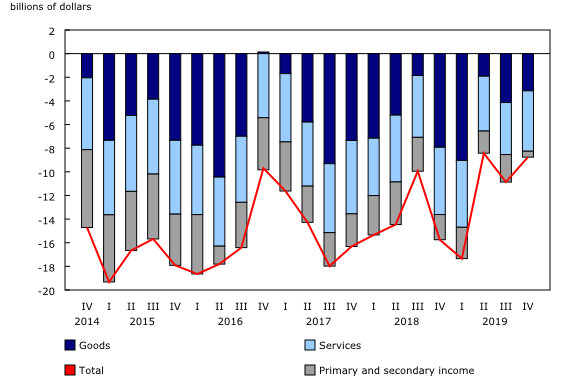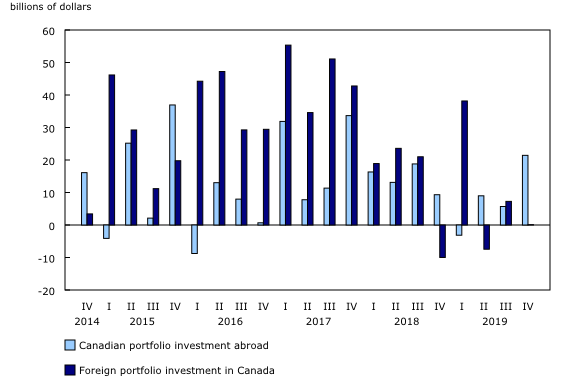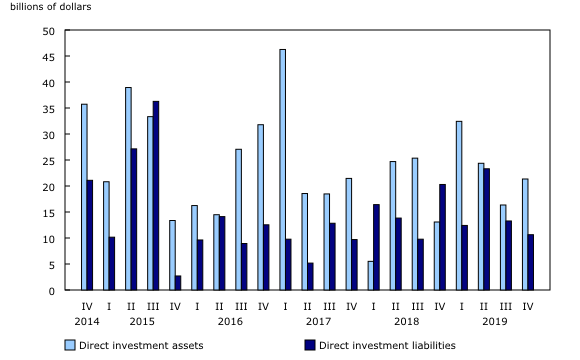Canada's balance of international payments, fourth quarter 2019
Archived Content
Information identified as archived is provided for reference, research or recordkeeping purposes. It is not subject to the Government of Canada Web Standards and has not been altered or updated since it was archived. Please "contact us" to request a format other than those available.
Released: 2020-02-27
-$8.8 billion
Fourth quarter 2019
Canada's current account deficit (on a seasonally adjusted basis) narrowed by $2.1 billion in the fourth quarter to $8.8 billion. The decrease mainly reflected a lower trade in goods deficit, as well as higher receipts from government transfers.
For the year 2019, the current account deficit stood at $45.4 billion, down $10.1 billion from 2018. The deficit in 2019 was the lowest since 2008, the last time Canada recorded a current account surplus.
In the financial account (unadjusted for seasonal variation), inflows of funds from abroad to finance the current account deficit mainly came from transactions in currency and deposits. Overall, non-residents increased their holdings of currency and deposits in Canada by $73.9 billion in the fourth quarter.
Portfolio and direct investment activity both generated a net outflow of funds from the economy in the fourth quarter, led by higher direct and portfolio investment abroad in the quarter. Direct investment abroad exceeded direct investment in Canada in all quarters of 2019.
Current account
Lower goods deficit as imports decline by more than exports
The deficit on trade in goods and services fell by $283 million to $8.3 billion in the fourth quarter, after widening the previous quarter. A lower goods deficit was partially offset by a higher services deficit in the quarter.
Goods exports decreased by $1.8 billion to $147.1 billion in the fourth quarter, a second quarterly decline which moderated the gains posted in the first half of the year. Disruptions in rail and pipeline coupled with reduced trade volumes of agricultural crops to China, and motor vehicles and parts to the United States, contributed to the decline in exports in the fourth quarter.
Over 3,750 enterprises in Canada export goods to China. These enterprises, led by those in British Columbia, export goods to nearly all provinces and regions in China. Shanghai, Beijing, Hong Kong, Shandong and Jiangsu are primary export destinations, according to a recent study on Canada's exports of goods to China.
Goods imports were down $2.8 billion to $150.2 billion, largely on lower imports of automotive products, primarily passenger vehicles and motor vehicle parts. The decline was similar in magnitude to the one observed for exports for this category of product.
The trade deficit in goods totalled $18.2 billion in 2019, the smallest deficit since 2014, when the last annual surplus was observed. Exports of goods increased in 2019 (+1.7%), albeit at a slower pace than in 2018 (+6.3%) and 2017 (+5.4%).
The trade in services deficit expanded by $0.7 billion in the fourth quarter. Exports were down 0.4%, while imports rose 1.5%, led by higher payments of personal travel services. For the year, the services deficit narrowed by $1.6 billion to $19.8 billion, mainly on higher exports of commercial services.
Other current account components contribute to a lower deficit
The current account is the broadest measure of cross-border transactions with the rest of the world covering, in addition to trade in goods and services, international activity in the form of investment income and transfers.
Canada's investment income balance went from a deficit to a surplus position in the fourth quarter. Stronger profits earned by Canadian direct investors on their assets abroad accounted for most of the increase in the quarter, and for the year 2019 as a whole. Overall, the investment income deficit narrowed by $4.0 billion in 2019.
The deficit on Canada's international transfers narrowed by $1.2 billion in the fourth quarter. Higher government transfer receipts, combined with lower payments from official contributions, both contributed to the lower deficit in the quarter.
Financial account
Canadian investment in foreign securities rises
Canadian investors acquired $21.4 billion of foreign securities in the fourth quarter, led by strong acquisitions of foreign shares. More precisely, investors purchased $13.8 billion of US shares in the quarter, following sales totalling $33.0 billion in the previous six quarters. At the same time, Canadian investors acquired $4.1 billion of foreign debt securities, predominantly corporate instruments.
On the other side of the ledger, foreign investment in Canadian securities slowed to $96 million in the fourth quarter, down from $7.3 billion in the third quarter. Foreign investors acquired Canadian money market instruments but reduced their exposure to Canadian bonds and shares in the fourth quarter. The reduction in Canadian shares reflected net retirements mainly resulting from mergers and acquisitions activity.
On an annual basis, foreign investment in Canadian securities slowed considerably to $38.1 billion in 2019, the lowest level of investment in 12 years. Meanwhile, Canadian investment in foreign securities was $33.0 billion.
Direct investment abroad increases
Direct investment abroad reached $21.3 billion in the fourth quarter, up from $16.3 billion in the third quarter. Mergers and acquisitions activity remained low at $4.2 billion, the lowest level in almost two years. The bulk of the investment in the quarter was directed to the United States.
Direct investment in Canada was $10.6 billion in the fourth quarter. Equity investments made by foreign parents in Canadian affiliates were moderated by repayments of Canadian parent debt owed to their foreign affiliates. Mergers and acquisitions activity totalled $5.6 billion in the fourth quarter, up from $4.0 billion in the third quarter. On a country basis, direct investment in Canada came primarily from Switzerland.
For the year 2019, direct investment abroad reached $94.5 billion, up significantly from $68.6 billion in 2018. Meanwhile, direct investment in Canada amounted to $59.6 billion, a level comparable to 2018. On an industry basis, the energy and mining as well as the manufacturing sectors attracted half of all direct investment in Canada. At $20.7 billion, cross-border mergers and acquisitions in Canada were the highest in four years.
Note to readers
Definitions
The balance of international payments covers all economic transactions between Canadian residents and non-residents in three accounts: the current account, the capital account and the financial account.
The current account covers transactions in goods, services, compensation of employees, investment income and secondary income (current transfers).
The current account data in this release are seasonally adjusted. For information on seasonal adjustment, see Seasonally adjusted data – Frequently asked questions.
The capital account covers capital transfers and transactions in non-produced, non-financial assets.
The financial account covers transactions in financial assets and liabilities.
In principle, a net lending (+) / net borrowing (-) derived from the sum of the current and capital accounts corresponds to a net lending (+) / net borrowing (-) derived from the financial account. In practice, as data are compiled from multiple sources, this is rarely the case and gives rise to measurement error. The discrepancy (net errors and omissions) is the unobserved net inflow or outflow.
Foreign direct investment is presented on an asset-liability principle basis (that is, gross basis) in the financial account. Foreign direct investment can also be presented on a directional principle basis (that is, net basis), as shown in supplementary foreign direct investment tables 36-10-0025-01, 36-10-0026-01, and 36-10-0473-01. The difference between the two foreign direct investment conceptual presentations resides in the classification of reverse investment such as (1) Canadian affiliates' claims on foreign parents and (2) Canadian parents' liabilities to foreign affiliates. Under the asset/liability presentation, (1) is classified as an asset and included in direct investment assets, also referred to as direct investment abroad in this text, and (2) is classified as a liability and included in direct investment liability, also referred to as direct investment in Canada in this text.
For more information on the balance of payments, consult chapter 8, "International accounts," in the User Guide: Canadian System of Macroeconomic Accounts, available on our website. The chapter also presents the most recent balance of payments statistics.
Real-time table
Real-time table 36-10-0042-01 will be updated on March 9. For more information, see Real-time tables.
Next release
Balance of international payments data for the first quarter will be released on May 28.
Products
The product Canada and the World Statistics Hub (13-609-X) is available online. This product illustrates the nature and extent of Canada's economic and financial relationship with the world using interactive graphs and tables. This product provides easy access to information on trade, investment, employment and travel between Canada and a number of countries, including the United States, the United Kingdom, Mexico, China and Japan.
The Economic accounts statistics portal, accessible from the subject module of our website, features an up-to-date portrait of national and provincial economies and their structure.
The Methodological Guide: Canadian System of Macroeconomic Accounts (13-607-X) is available.
The User Guide: Canadian System of Macroeconomic Accounts (13-606-G) is also available.
Contact information
For more information, contact us (toll-free 1-800-263-1136; 514-283-8300; STATCAN.infostats-infostats.STATCAN@canada.ca).
To enquire about the concepts, methods or data quality of this release, contact Éric Simard (613-219-5932; eric.simard@canada.ca), International Accounts and Trade Division.
- Date modified:




